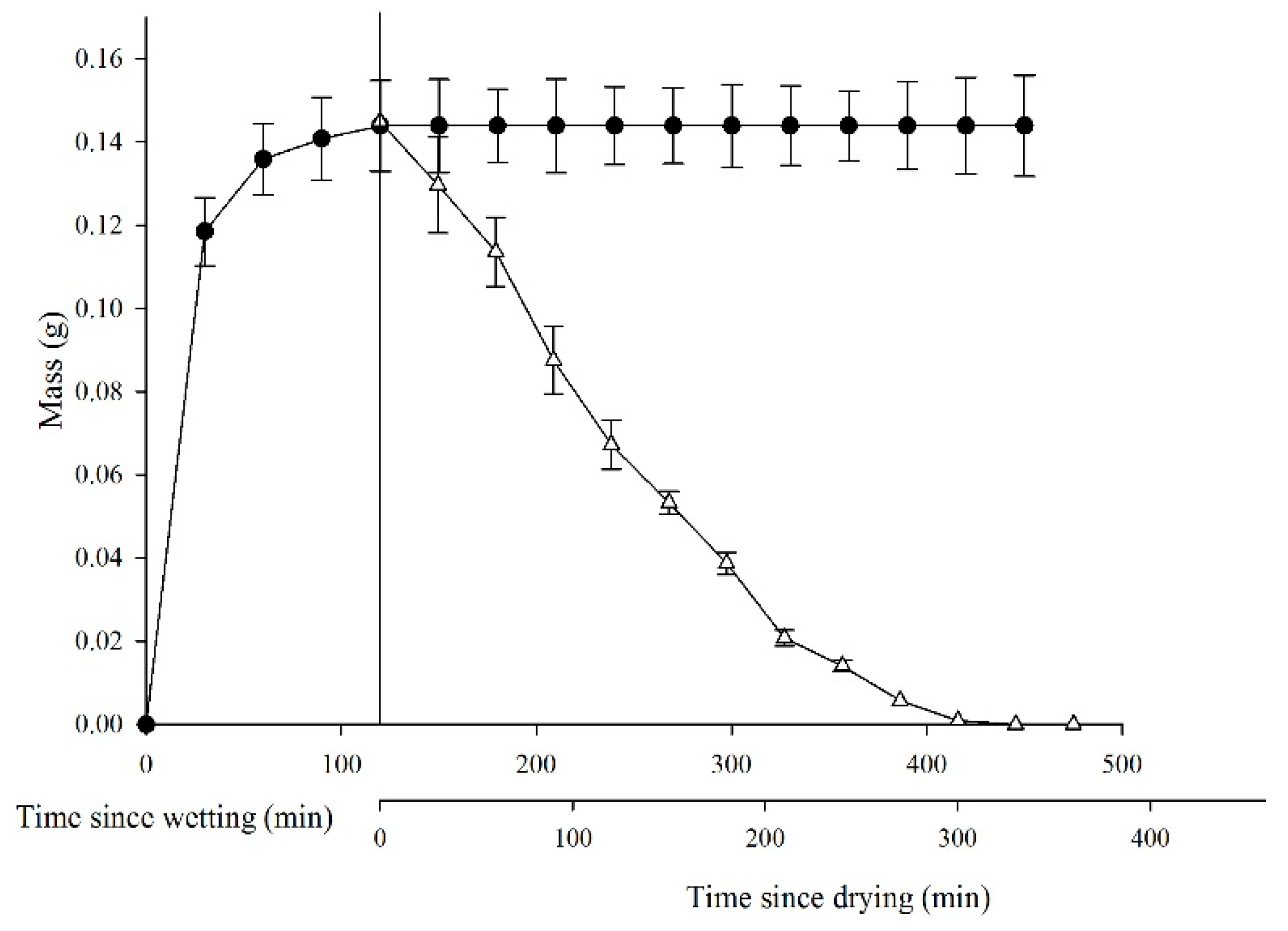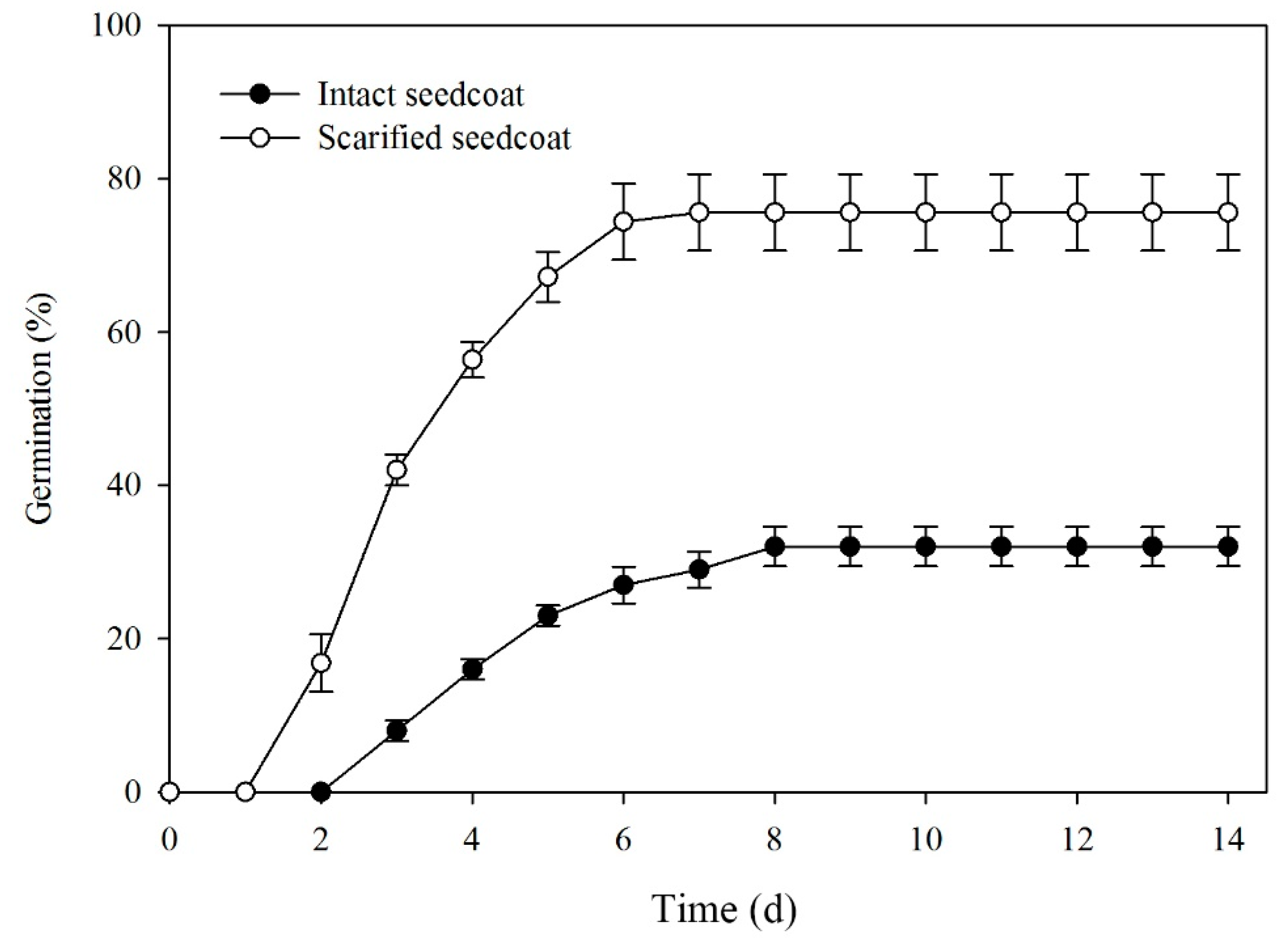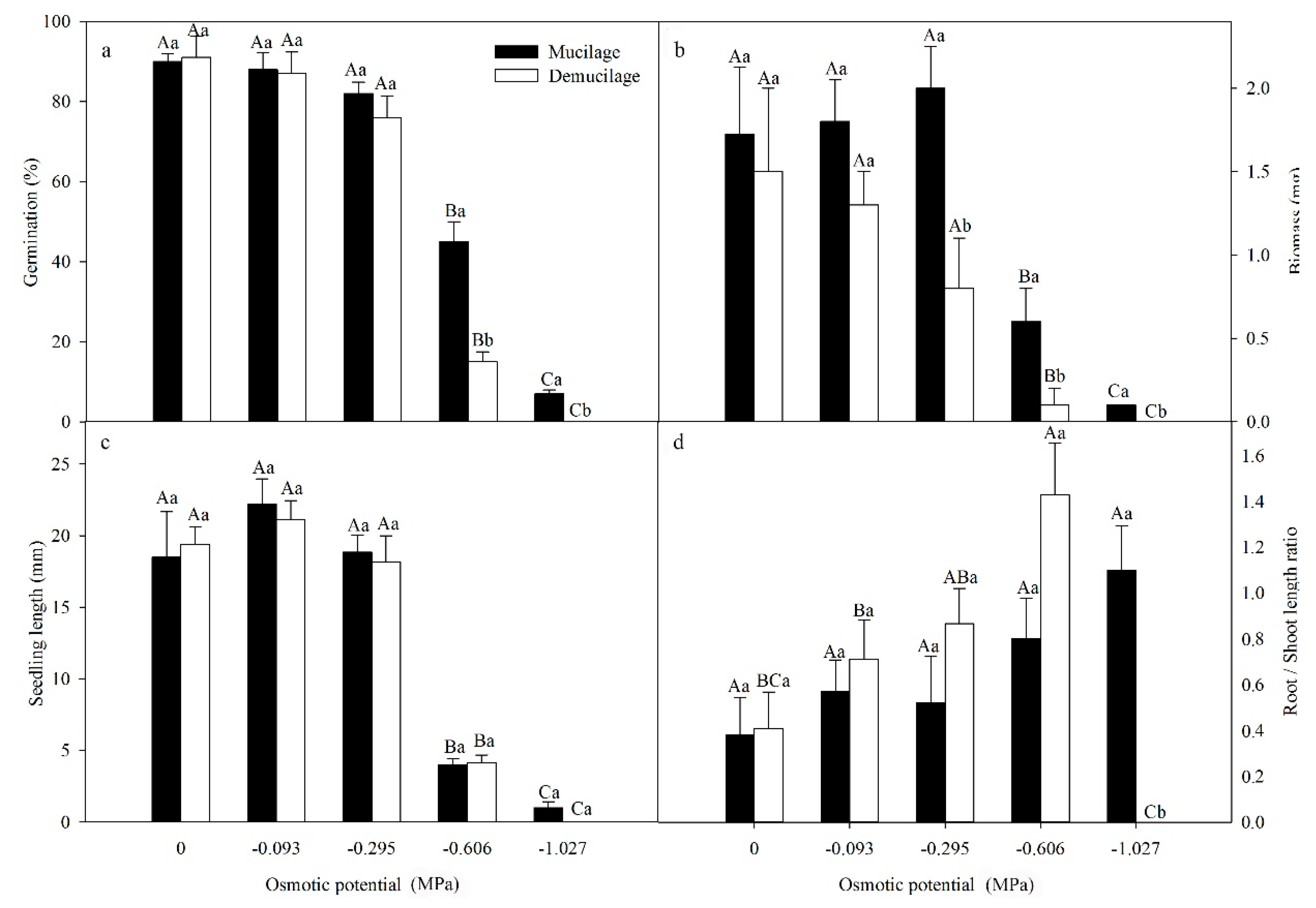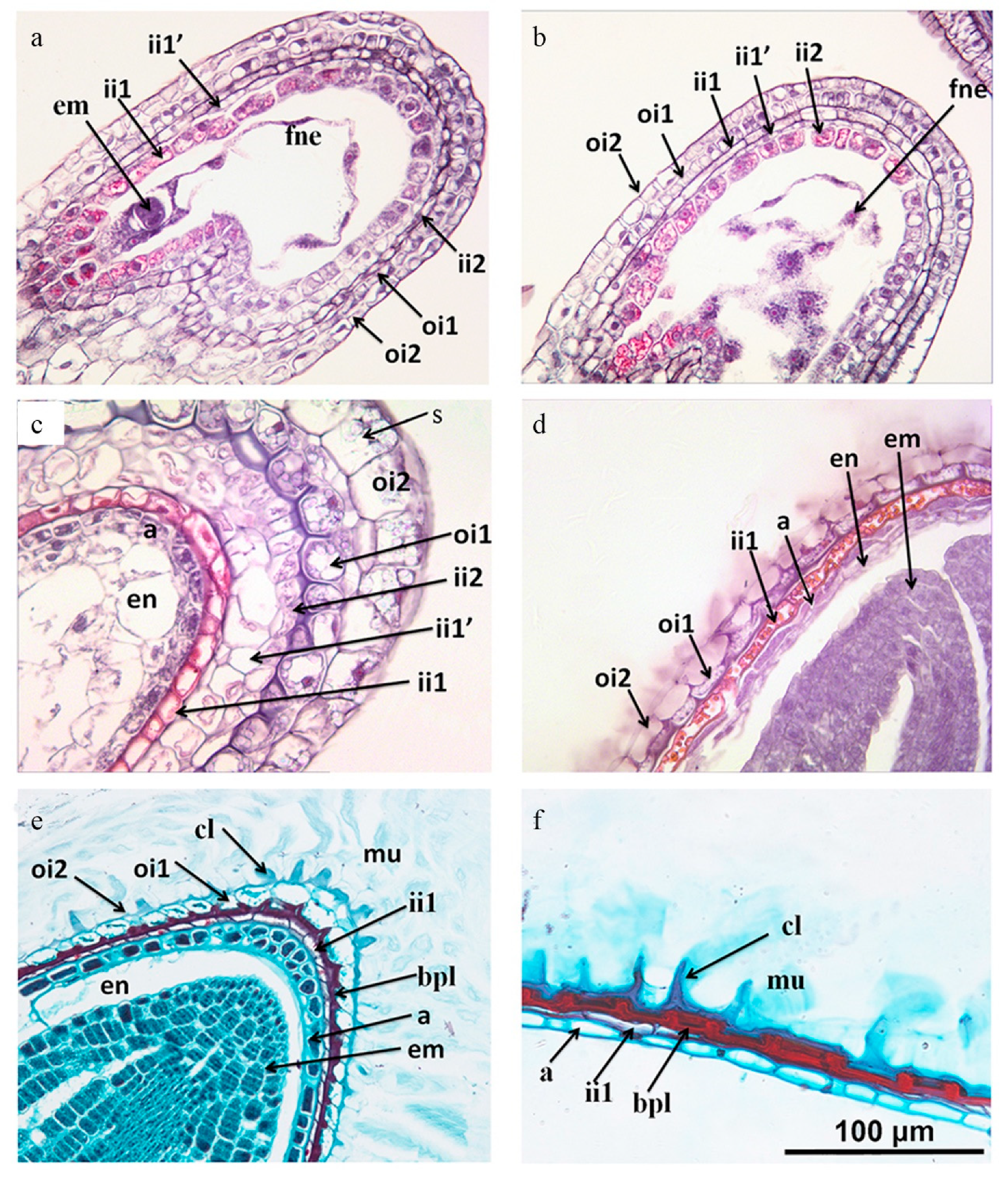Seed Biology of Lepidium apetalum (Brassicaceae), with Particular Reference to Dormancy and Mucilage Development
Abstract
1. Introduction
2. Results
2.1. Seed Characteristics
2.2. Water Absorption and Dehydration Characteristics
2.3. Effects of Temperature, Light, and/or GA3 on Germination of Fresh and Dry-Stored Seeds
2.4. Effects of Cold Stratification on Germination
2.5. Scarification of the Seed Coat
2.6. Effects of PEG on Germination and Seedlings of Mucilaged and Demucilaged Seeds
2.7. Anatomical Changes of Mucilage During Seed Development
3. Discussion
4. Materials and Methods
4.1. Seed Collection and Site Description
4.2. Seed Characteristics
4.3. Water Absorption and Dehydration Characteristics of Seeds
4.4. Effects of Temperature, Light, and/or GA3 on Germination of Fresh and Dry-Stored Seeds
4.5. Effects of Cold Stratification on Germination
4.6. Scarification of the Seed Coat
4.7. Effects of PEG on Germination and Seedlings of Mucilaged and Demucilaged Seeds
4.8. Anatomical Changes of Mucilage during Seed Development
4.9. Data Analyses
5. Conclusions
Author Contributions
Funding
Conflicts of Interest
References
- West-Eberhard, M.J. Developmental Plasticity and Evolution; Oxford University Press: Oxford, UK, 2003. [Google Scholar]
- Baskin, C.C.; Baskin, J.M. Seeds: Ecology, Biogeography, and Evolution of Dormancy and Germination, 2nd ed.; Academic Press: San Diego, CA, USA, 2014. [Google Scholar]
- Western, T.L.; Burn, J.; Tan, W.L.; Skinner, D.J.; Martin-McCaffrey, L.; Moffatt, B.A.; Haughn, G.W. Isolation and characterization of mutants defective in seed coat mucilage secretary cell development in Arabidopsis. Plant Physiol. 2001, 122, 345–355. [Google Scholar] [CrossRef] [PubMed]
- Benech-Arnold, R.L.; Sanchez, R.A.; Forcella, F.; Kruk, B.C.; Ghersa, C.M. Environmental control of dormancy in weed seed banks in soil. Field Crop. Res. 2000, 67, 105–122. [Google Scholar] [CrossRef]
- Finch-Savage, W.E.; Leubner-Metzger, G. Seed dormancy and the control of germination. New Phytol. 2006, 171, 501–523. [Google Scholar] [CrossRef] [PubMed]
- Grubb, P.J. The maintenance of species richness in plant communities: The importance of the regeneration niche. Biol. Rev. 1977, 52, 107–145. [Google Scholar] [CrossRef]
- Francoz, E.; Ranocha, P.; Burlat, V.; Dunand, C. Arabidopsis seed mucilage secretory cells: Regulation and dynamics. Trends Plant Sci. 2015, 20, 515–524. [Google Scholar] [CrossRef] [PubMed]
- Phan, J.L.; Burton, R.A. New insights into the composition and structure of seed mucilage. Annu. Plant Rev. Online 2018, 1, 63–104. [Google Scholar]
- Western, T.L.; Skinner, D.J.; Haughn, G.W. Differentiation of mucilage secretory cells of the Arabidopsis seed coat. Plant Physiol. 2000, 122, 345–356. [Google Scholar] [CrossRef]
- Yang, X.; Baskin, J.M.; Baskin, C.C.; Huang, Z. More than just a coating: Ecological importance, taxonomic occurrence and phylogenetic relationships of seed coat mucilage. Perspect. Plant Ecol. Evol. Syst. 2012, 14, 434–442. [Google Scholar] [CrossRef]
- Yang, X.J.; Dong, M.; Huang, Z. Role of mucilage in the germination of Artemisia sphaerocephala (Asteraceae) achenes exposed to osmotic stress and salinity. Plant Physiol. Bioch. 2010, 48, 131–135. [Google Scholar] [CrossRef]
- Di Marsico, A.; Scrano, L.; Labella, R.; Lanzotti, V.; Rossi, R.; Cox, L.; Perniola, M.; Amato, M. Mucilage from fruits/seeds of chia (Salvia hispanica L.) improves soil aggregate stability. Plant Soil 2018, 425, 57–69. [Google Scholar] [CrossRef]
- Thapliyal, R.C.; Phartyal, S.S.; Baskin, J.M.; Baskin, C.C. Role of mucilage in germination of Dillenia indica (Dilleniaceae) seeds. Aust. J. Bot. 2008, 56, 583–589. [Google Scholar] [CrossRef]
- Bhatt, A.; Santo, A.; Gallacher, D. Seed mucilage effect on water uptake and germination in five species from the hyper-arid Arabian desert. J. Arid. Environ. 2016, 128, 73–79. [Google Scholar] [CrossRef]
- Grubert, M. Studies on the distribution of myxospermy among seeds and fruits of Angiospermae and its ecological importance. Acta Biol. Venez. 1974, 8, 315–352. [Google Scholar]
- Engelbrecht, M.; Bochet, E.; García-Fayos, P. Mucilage secretion: An adaptive mechanism to reduce seed removal by soil erosion? Biol. J. Linn. Soc. 2014, 111, 241–251. [Google Scholar] [CrossRef]
- Deng, W.N.; Hallett, P.D.; Jeng, D.S.; Squire, G.R.; Toorop, P.E.; Iannetta, P.P.M. The effect of natural seed coatings of Capsella bursa-pastoris L. Medik. (shepherd’s purse) on soil-water retention, stability and hydraulic conductivity. Plant Soil 2015, 387, 167–176. [Google Scholar] [CrossRef]
- Yang, X.J.; Baskin, C.C.; Baskin, J.M.; Gao, R.R.; Yang, F.; Wei, L.L.; Li, L.L.; He, H.J.; Huang, Z.Y. Hydrated mucilage reduces post-dispersal seed removal of a sand desert shrub by ants in a semiarid ecosystem. Oecologia 2013, 173, 1451–1458. [Google Scholar] [CrossRef]
- He, S.Y. Flora of Beijing, 2nd ed.; Beijing Press: Beijing, China, 1992. [Google Scholar]
- Zhao, H.X.; Li, Q.; Li, G.; Du, Y. Differential gene expression in response to cold stress in Lepidium apetalum during seedling emergence. Biol. Plant. 2012, 56, 64–70. [Google Scholar] [CrossRef]
- Shi, P.P.; Chao, L.P.; Wang, T.X.; Liu, E.W.; Han, L.F.; Zong, Q.; Li, X.X.; Zhang, Y.; Wang, T. New bioactive flavonoid glycosides isolated from the seeds of Lepidium apetalum Willd. Fitoterapia 2015, 103, 197–205. [Google Scholar] [CrossRef]
- Xu, W.; Chu, K.; Li, H.; Chen, L.; Zhang, Y.; Tang, X. Extraction of Lepidium apetalum seed oil using supercritical carbon dioxide and anti-oxidant activity of the extracted oil. Molecules 2011, 16, 10029–10045. [Google Scholar] [CrossRef]
- Tang, A.J.; Tian, M.H.; Long, C.L. Dormancy and germination in short-lived Lepidium perfoliatum L. (Brassicaceae) seeds. Pak. J. Bot. 2010, 42, 201–211. [Google Scholar]
- Meng, J.; Li, Q.; Li, G. Physiological characteristic of seed germination of two species of Lepidium L. Biotechnology 2008, 18, 32–35. [Google Scholar]
- Toole, E.H.; Toole, V.K.; Hendricks, S.B.; Borthwick, H.A. Effect of temperature on germination of light-sensitive seeds. Proc. Int. Seed Test Assoc. 1957, 22, 196–204. [Google Scholar]
- Lu, J.J.; Tan, D.Y.; Baskin, J.M.; Baskin, C.C. Fruit and seed heteromorphism in the cold desert annual ephemeral Diptychocarpus strictus (Brassicaceae) and possible adaptive significance. Ann. Bot. 2010, 105, 999–1014. [Google Scholar] [CrossRef] [PubMed]
- Van der Fiji, L. Principles of dispersal in higher plants, 2nd ed.; Springer: Berlin, Germany, 1982. [Google Scholar]
- Huang, Z.; Gutterman, Y. Artemisia monosperma achene germination in sand: Effects of sand depth, water/sand content, cyanobacterial sand crust and temperature. J. Arid. Environ. 1998, 38, 27–43. [Google Scholar] [CrossRef]
- Huang, Z.; Gutterman, Y.; Hu, Z. Structure and function of mucilaginous achenes of Artemisia monosperma inhabiting the Negev Desert of Israel. Isr. J. Plant Sci. 2000, 48, 255–266. [Google Scholar] [CrossRef]
- Gutterman, Y. Survival strategies of annual desert plants. In Adaptations of Desert Organisms; Springer: Heidelberg, Germany; New York, NY, USA, 2002. [Google Scholar]
- Liu, X.F. The Reproductive Ecology on Some Ephemeral Species of Brassicaceae; Xinjiang Agricultural University: Xinjiang, China, 2007. [Google Scholar]
- Ye, X.; Li, L.; Baskin, C.C.; Baskin, J.M.; Du, J.; Huang, Z. Sand burial helps regulate timing of seed germination of a dominant herb in an inland dune ecosystem with a semiarid temperate climate. Sci. Total Environ. 2019, 680, 44–50. [Google Scholar] [CrossRef]
- Torra, J.; Recasens, J. Demography of corn poppy (Papaver rhoeas) in relation to emergence time and crop competition. Weed Sci. 2008, 56, 826–833. [Google Scholar] [CrossRef]
- Torra, J.; Royo-Esnal, A.; Recasens, J. Germination ecology of five Ranunculaceae arable weeds. Weed Res. 2015, 55, 503–513. [Google Scholar] [CrossRef]
- Flores, J.; González-Salvatierra, C.; Jurado, E. Effect of light on seed germination and seedling shape of succulent species from Mexico. J. Plant Ecol. 2016, 9, 174–179. [Google Scholar] [CrossRef]
- Schutz, W.; Milberg, P.; Lamont, B.B. Seed dormancy, after-ripening and light requirements of four annual Asteraceae in south-western Australia. Ann. Bot. 2002, 90, 707–714. [Google Scholar] [CrossRef]
- Torra, J.; Recasens, J.; Royo-Esnal, A. Seedling emergence response of rare arable plants to soil tillage varies by species. PLoS ONE 2018, 13, e0199425. [Google Scholar] [CrossRef] [PubMed]
- Sun, Y.; Tan, D.Y.; Baskin, C.C.; Baskin, J.M. Role of mucilage in seed dispersal and germination of the annual ephemeral Alyssum minus (Brassicaceae). Austra. J. Bot. 2012, 60, 439. [Google Scholar] [CrossRef]
- Beeckman, T.; De Rycke, R.; Viane, R.; Inzé, D. Histological study of seed coat development in Arabidopsis thaliana. J. Plant Res. 2000, 113, 139–148. [Google Scholar] [CrossRef]
- Dale, W.T.; Scott, L.I. Structural characteristics of the testa in Capsella and Sinapis. Proc. Leeds Philos. Lit. Soc. 1943, 4, 111–122. [Google Scholar]
- Western, T.L. The sticky tale of seed coat mucilages: Production, genetics, and role in seed germination and dispersal. Seed Sci. Res. 2012, 22, 1–25. [Google Scholar] [CrossRef]
- Windsor, J.B.; Symonds, V.V.; Mendenhall, J.; Lloyd, A.L. Arabidopsis seed coat development: Morphological differentiation of the outer integument. Plant J. 2000, 22, 483–493. [Google Scholar] [CrossRef]
- Debeaujon, I.; Nesi, N.; Perez, P.; Devic, M.; Grandjean, O.; Caboche, M.; Lepiniec, L. Proanthocyanidin-accumulating cells in Arabidopsis testa: Regulation of differentiation and role in seed development. Plant Cell 2003, 15, 2514–2531. [Google Scholar] [CrossRef]
- Money, N.P. Osmotic pressure of aqueous polyethylene glycols. Plant Physiol. 1989, 91, 766–769. [Google Scholar] [CrossRef]
- Hatami, M.; Hosseini, S.M.; Ghorbanpour, M.; Kariman, K. Physiological and antioxidative responses to GO/PANI nanocomposite in intact and demucilaged seeds and young seedlings of Salvia Mirzayanii. Chemosphere 2019, 233, 920–935. [Google Scholar] [CrossRef]
- Huang, Z.; Boubriak, I.; Osborne, D.J.; Dong, M.; Gutterman, Y. Possible role of pectin-containing mucilage and dew in repairing embryo DNA of seeds adapted to desert conditions. Ann. Bot. 2008, 101, 277–283. [Google Scholar] [CrossRef]






| Length (mm) | Width (mm) | Mass of 1000 Seeds (g) | |
|---|---|---|---|
| Freshly matured seeds | 1.24 ± 0.03 | 0.75 ± 0.33 | 0.21 ± 0.01 |
| Imbibed seeds | 1.82 ± 0.25 | 1.52 ± 0.55 | 1.52 ± 0.01 |
| Source | df | SS | MS | F-Value | P-Value |
|---|---|---|---|---|---|
| Temperature | 3 | 27325.0 | 9108.333 | 236.069 | <0.001 |
| Light | 1 | 5724.5 | 5724.500 | 148.367 | <0.001 |
| GA3 | 3 | 66996.0 | 22332.000 | 578.799 | <0.001 |
| Temperature × Light | 3 | 4356.5 | 1452.167 | 37.637 | <0.001 |
| Temperature × GA3 | 9 | 6373.0 | 708.111 | 18.353 | <0.001 |
| Light × GA3 | 3 | 1445.5 | 481.833 | 12.488 | <0.001 |
| Temperature × Light × GA3 | 9 | 2329.5 | 258.833 | 6.708 | <0.001 |
| Source | df | SS | MS | F-Value | P-Value |
|---|---|---|---|---|---|
| Storage time | 3 | 50320.188 | 16773.396 | 509.894 | <0.001 |
| Temperature | 3 | 30855.687 | 10285.229 | 312.661 | <0.001 |
| GA3 | 3 | 84836.188 | 28278.729 | 859.645 | <0.001 |
| Storage time × Temperature | 9 | 8252.563 | 916.951 | 27.874 | <0.001 |
| Storage time × GA3 | 9 | 8858.063 | 984.229 | 29.920 | <0.001 |
| Temperature × GA3 | 9 | 8566.563 | 951.840 | 28.935 | <0.001 |
| Storage time × Temperature × GA3 | 27 | 15440.188 | 571.859 | 17.384 | <0.001 |
© 2020 by the authors. Licensee MDPI, Basel, Switzerland. This article is an open access article distributed under the terms and conditions of the Creative Commons Attribution (CC BY) license (http://creativecommons.org/licenses/by/4.0/).
Share and Cite
Zhang, K.; Zhang, Y.; Ji, Y.; Walck, J.L.; Tao, J. Seed Biology of Lepidium apetalum (Brassicaceae), with Particular Reference to Dormancy and Mucilage Development. Plants 2020, 9, 333. https://doi.org/10.3390/plants9030333
Zhang K, Zhang Y, Ji Y, Walck JL, Tao J. Seed Biology of Lepidium apetalum (Brassicaceae), with Particular Reference to Dormancy and Mucilage Development. Plants. 2020; 9(3):333. https://doi.org/10.3390/plants9030333
Chicago/Turabian StyleZhang, Keliang, Yin Zhang, Yusong Ji, Jeffrey L. Walck, and Jun Tao. 2020. "Seed Biology of Lepidium apetalum (Brassicaceae), with Particular Reference to Dormancy and Mucilage Development" Plants 9, no. 3: 333. https://doi.org/10.3390/plants9030333
APA StyleZhang, K., Zhang, Y., Ji, Y., Walck, J. L., & Tao, J. (2020). Seed Biology of Lepidium apetalum (Brassicaceae), with Particular Reference to Dormancy and Mucilage Development. Plants, 9(3), 333. https://doi.org/10.3390/plants9030333




